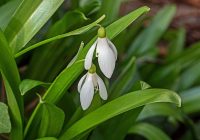Dr Phil Smith’s Wildlife Notes
February 2022
February 2022 will be remembered for a cluster of three named storms: Dudley, Eunice and Franklin, which arose from an exceptionally active North Atlantic Jet Stream. They caused considerable disruption nationally, including flooding in some areas. Fortunately, we escaped the worst of it. Although it rained here on 21 days, most of it was light, total rainfall being about average for the month. The sand-dune water-table rose by about 10 cm. We had hardly any frost and no snow in what was the UK’s eighth mildest February on record.
On 1st of the month, my spirits were lifted by the first Snowdrops in flower on Range Lane, while Jays called from the woods. Seedlings were already germinating on an area of bare sand created where a large Sea Buckthorn clump had been taken out by the National Trust. I was intrigued by circular marks on damp sand in the Devil’s Hole caused by the lashing of Marram leaves in the stormy winds. The following day, I went to see the new scrapes in Ravenmeols Local Nature Reserve excavated in areas also cleared of Sea Buckthorn by the National Trust. Two of them are shallow and gently shelving – ideal for Natterjack Toads. Two others are deeper and less suitable for Natterjacks but should attract other wildlife, including dragonflies. A real highlight was a bush of the nationally rare Don’s Willow which I had previously missed, probably because it had been partially concealed by Sea Buckthorn. Its flame-red stems were unmissable and I was able to confirm its identity by the arrangement of buds and the shape of dead leaves underneath the bush.
The increasing numbers of Snowdrops reminded me to visit the relict dunes at Kenilworth Road, Ainsdale, where a single plant of Greater Snowdrop I found ten years ago was the sole representative of this species I have seen on the coast. It has much broader, hooded leaves and larger flowers than the common form. But was still there? Happily it was! As the plant was in danger of being overgrown by Ivy, I cleared a patch around it. Common Whitlowgrass, a member of the cabbage family, was already showing its tiny white flowers, while a Chaffinch was singing loudly from the trees. Cabin Hill Wood also produced its usual fine display of Snowdrops and I was surprised to find a group of Scarlet Elf-cups fungi, the first time I had seen it here. Natural England contractors had taken a huge amount of Grey Willow out of the slacks on the National Nature Reserve; it was piled up ready for chipping. I had arranged, beforehand, for several rare hybrid willows to be marked and retained. Similar work in 2005 led to a remarkable variety of plants growing up in the cleared area. During my walk around the reserve, I recorded eight Snipe, four Teal and a pair of Greylag geese. I also had a brief view of a Roe Deer heading for cover. As mentioned in earlier notes, these small native deer are becoming widespread in the dunes and, if numbers rise, they may help to graze rank vegetation and browse scrub.
The Green Snowdrop is the third member of its genus found on the Sefton Coast, its only known colony being at Hesketh Road, Marshside. As I hadn’t been to see it for some years, I checked it out late in the month. There were two patches surviving but heavily invaded by Ivy and bramble. The name comes from the broad, bright-green leaves, the flowers being similar to the ordinary Snowdrop. I also visited the RSPB hide where five Avocets and a Great White Egret were showing in the distance, while colourful Shovelers and smart Pintails were right in front. A short session on the very cold watch-point overlooking Crossens Marsh produced a distant ‘ringtail’ Hen Harrier.
On 27th I went to Hightown to find out how much erosion had been caused by the storms. A Raven flew over as I got out of the car. It was lucky that the highest tide during this period was 1 m lower than the maximum possible. Nevertheless, 1.5-2 m had been lost from the higher dunes and up to 5 m from the low dunes in front of the northern reedbed. This ongoing erosion is destroying important habitat for dune flora and fauna.
Up to a record number of 18 volunteer ‘Buckthorn Bashers’ met three times during the month, clearing mainly Sea Buckthorn on the dunes north and west of Sands Lake, Ainsdale. We welcomed several new recruits, including two Liverpool University students, one of whom hopes to update information on the Baltic Rush at Birkdale for his dissertation.
Finally, on 17th I took part in an online Sands of LIFE workshop on Rabbits as sand-dune managers. This provided useful insights on the importance of Rabbits as grazers of dune vegetation both in the UK and continental Europe. The general consensus was that we need a lot more of them!






